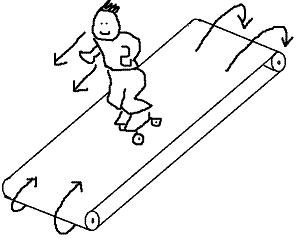If planes could take off, and potentially land, this way then why do we use or need long runways at airports or aircraft carriers? I'm not an engineer, but would have to assume that most jet engines cannot easily create enough air flow over their wings, basically sitting still, to lift off. Otherwise, Harrier jets and other vertical take-off jets wouldn't need nozzles that can turn vertically to the ground for take off. I would have to assume that a plane taking off this way would be very unstable, dangerous and difficult to control.
Look at it this way - the only thing that matters is the relationship between the plane and the air mass around it. If you were in a plane flying at 100 mph and flying directly into a head wind of 100 mph, the plane would not fall out of the sky. It may be motionless in RELATION to the ground, but in RELATION to the air around it, it is still going 100 mph. The riddle was about the relationship between the plane and the conveyor belt (ground) and did not say anything about the relationship between the plane and its other surroundings (air).






